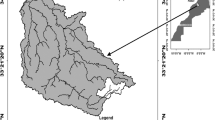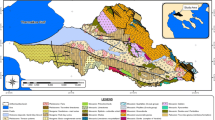Abstract
Magnetic measurements of soils are an effective research tool in assessing soil erosion. This approach is based on detecting layers showing different magnetic properties in vertical soil profiles and lateral catenas. The objective of this research is to compile data on magnetic susceptibility (MS) of soils in Eastern Ukraine to assess the soil erosion rates. The chernozems of Tcherkascy Tishki (Kharkov Region, Ukraine) have undergone a field crop rotation without proper soil conservation technologies being applied. We conducted an intrinsic element grouping of the magnetic susceptibility values and demonstrated that they can be used as MS cartograms in soil erosion mapping. The study showed a strong correlation between the MS values and the erosion index. MS and the erosion index were found to correlate with the humus content. Magnetic mineralogical analyses suggest the presence of highly magnetic minerals (magnetite and maghemite) as well as weakly magnetic goethite, ferrihydrite, and hematite. Stable pseudosingle-domain (PSD), single-domain (SD), and superparamagnetic (SP) grains of pedogenic origin dominate in the studied chernozems. Being an effective, quick and low cost alternative, magnetic methods can be successfully used in the soil erosion investigations.
Similar content being viewed by others
References
Armstrong A., Quinton J.N. and Maher B.A., 2012. Thermal enhancement of natural magnetism as a tool for tracing eroded soil. Earth Surf. Process. Landf., 37, 1567–1572.
Brevik E.C., Calzolari C., Miller B.A., Pereira P., Kabala C., Baumgarten A. and Jordán A., 2016. Soil mapping, classification, and pedologic modeling: history and future directions. Geoderma, 264, 256–274.
Brevik E.C. and Hartemink A.E., 2013. Soil maps of the United States of America. Soil Sci. Soc. Am. J., 77, 1117–1132.
Bulygin S.Y., Breus N.M. and Semynozhenko T.A., 1998. Methods of determining the degree of soil erodibility on slopes. Pochvovedenie, 6, 714–718 (in Russian).
Cerdà A., Imeson A.C. and Calvo C.A., 1995. Fire and aspect induced differences on the erodibility and hydrology of soils at La Costera, Valencia, southeast Spain. Catena, 24, 289–304.
Dunlop D.J., 2002. Theory and application of the Day plot (Mrs/Ms versus Hcr/Hc). 2. Application to data for rocks, sediments, and soils. J. Geophys. Res.-Solid Earth, 107, 2057.
Dunlop D.J. and Özdemir Ö., 1997. Rock Magnetism: Fundamentals and Frontiers. Cambridge University Press, New York.
Day R., Fuller M. and Schmidt V.A., 1977. Hysteresis properties of titanomagnetites: grain-size and compositional dependence. Phys. Earth Planet. Inter., 13, 260–267.
Evans M.E. and Heller F., 2003. Environmental Magnetism. Principles and Applications of Enviromagnetics. Academic Press, San Diego, CA.
Fernandez-Calvino D., Garrido-Rodriguez B., Lopez-Periago J.E., Paradelo M. and Arias-Estevez M., 2013. Spatial distribution of copper fractions in a vineyard soil. Land Degrad. Dev., 24, 556–563.
García-Orenes F., Cerdà A., Mataix-Solera J., Guerrero C., Bodí M. B., Arcenegui V., Zornoza R. and Sempere J.G., 2009. Effects of agricultural management on surface soil properties and soil-water losses in eastern Spain. Soil Tillage Res., 106, 117–123.
Gennadiev A.N., Golosov V.N., Chernyanskii S.S., Markelov M.V., Kovach R.G., Belyaev V.R. and Ivanova N.N., 2006. Comparative assessment of the contents of magnetic spherules, 137Cs, and 210Pb in soils as applied for the estimation of soil erosion. Eurasian Soil Sci., 39, 1100–1115.
Gennadiev A.N., Zhidkin A.P., Olson K.R. and Kachinskii V.L., 2010. Soil erosion under different land uses: assessment by the magnetic tracer method. Eurasian Soil Sci., 43, 1047–1054.
Górka-Kostrubiec B., Teisseyre-Jeleńska M. and Dytłow S.K., 2016. Magnetic properties as indicators of Chernozem soil development. Catena, 138, 91–102.
Gubbins D. and Herrero-Bervera E., 2007. Encyclopedia of Geomagnetism and Paleomagnetism. Springer-Verlag, Dordrecht, The Netherlands.
Hanesch M., Stanjek H. and Petersen N., 2006. Thermomagnetic measurements of soil iron minerals: the role of organic carbon. Geophys. J. Int., 165, 53–61.
Hanesch M. and Scholger R., 2005. The influence of soil type on the magnetic susceptibility measured throughout soil profiles. Geophys. J. Int., 161, 50–56.
Haregeweyn N., Poesen J., Verstraeten G., Govers G., de Vente J., Nyssen J., Deckers J. and Moeyersons J., 2013. Assessing the performance of a spatially distributed soil erosion and sediment delivery model (WATEM/SEDEM in Northern Ethiopia). Land Degrad. Dev., 24, 188–204.
Ibáñez J.J., Pérez-Gómez R. and Martínez F.S.J., 2009. The spatial distribution of soils across Europe: A fractal approach. Ecol. Complex., 6, 294–301.
Jakšík O., Kodešová R., Kapička A., Klement A., Fér M. and Nikodem A., 2016. Using magnetic susceptibility mapping for assessing soil degradation due to water erosion. Soil Water Res., 11(2), 105–113.
Jordanova D. and Jordanova N., 2016. Thermomagnetic behavior of magnetic susceptibility - heating rate and sample size effects. Front. Earth Sci., 3, 90, DOI: 10.3389/feart.2015.00090.
Jordanova D., Jordanova N. and Petrov P., 2014. Pattern of cumulative soil erosion and redistribution pinpointed through magnetic signature of Chernozem soils. Catena, 120, 46–56.
Jordanova D., Jordanova N. and Werban U., 2013. Environmental significance of magnetic properties of Gley soils near Rosslau (Germany). Environ. Earth Sci., 69, 1719–1732.
Jordanova D., Jordanova N., Atanasova A., Tsacheva T. and Petrov P., 2011. Soil tillage erosion by using magnetism of soils–a case study from Bulgaria. Environ. Monit. Assess., 183, 381–394.
Kapička A., Dlouhá S., Grison H., Jakšík O., Petrovský E. and Kodešová R., 2013. Magnetic properties of soils - a basis for erosion study at agricultural land in Southern Moravia. SGEM2013 Conference Proceedings, 577–584, DOI: 10.5593/SGEM2013/BC3/S13.013.
Karchegani P.M., Ayoubi S., Lu S.G. and Honarju N., 2011. Use of magnetic measures to assess soil redistribution following deforestation in hilly region. J. Appl. Geophys., 75, 227–236.
Kirkby M.J. and Morgan R.P.C. (Eds), 1980. Soil Erosion. John Wiley, Chichester.
Kruglov O. and Menshov O., 2017. To the soil magnetic susceptibility application in modern soil science. 16th International Conference on Geoinformatics - Theoretical and Applied Aspects. European Association of Geoscientists & Engineers, Houten, The Netherlands, DOI: 10.3997/2214-4609.201701906 (in Russian).
Kutsenko N.V., 2003. Geosystem concept of erosion process modelling. Newsletter of the European Society for Soil Conservation, 2, 4–8.
Lovley D.R. and Philips E.J.P., 1986. Organic matter mineralization with reduction of ferric iron in anaerobic sediments. Appl. Environ. Microbiol., 51, 683–689.
Maher B.A., 1998. Magnetic properties of modern soils and Quaternary loessic paleosols: paleoclimatic implications. Palaeogeogr. Palaeoclimat. Palaeoecol., 137, 25–54.
Mandal D. and Sharda V.N., 2013. Appraisal of soil erosion risk in the Eastern Himalayan region of India for soil conservation planning. Land Degrad. Dev., 24, 430–437.
Menshov O., Kruglov O. and Sukhorada A., 2012. Informational content of the soil magnetism indicators for solving agrogeophysical and soil science tasks. Sci. Bull. Nat. Mining Univ., 3, 7–12 (in Russian).
Menshov O., Kuderavets R., Vyzhva S., Maksymchuk V., Chobotok I. and Pastushenko T., 2016. Magnetic studies at Starunia paleontological and hydrocarbon bearing site (Carpathians, Ukraine). Stud. Geophys. Geod., 60, 731–746.
Mighall T.M., Foster I.D.L., Rowntree K.M. and Boardman J., 2012. Reconstructing recent land degradation in the semi-arid Karoo of the South Africa: A poleoecological study at Compassberg, Eastern Cape. Land Degrad. Dev., 23, 523–533.
Müller M., Kurz G. and Yaramanci U., 2009. Influence of tillage methods on soil water content and geophysical properties. Near Surf. Geophys., 7, 27–36.
Mullins C.E., 1977. Magnetic susceptibility of the soil and its significance in soil science - a review. J. Soil Sci., 28, 223–246.
Nazarok P., Kruglov O., Menshov O., Kutsenko M. and Sukhorada A., 2014. Mapping soil erosion using magnetic susceptibility. A case study in Ukraine. Solid Earth Discuss., 6, 831–848
Olson K.R., Gennadiyev A.N., Zhidkin A.P., Markelov M., Golosov V.N. and Lang J.M., 2013. Use of magnetic tracer and radio-cesium methods to determine past cropland soil erosion amounts and rates. Catena, 104, 103–110.
Pereira P., Cerdà A., Úbeda X., Mataix-Solera J., Martin D., Jordán A. and Burguet M., 2013. Spatial models for monitoring the spatio-temporal evolution of ashes after fire - a case study of a burnt grassland in Lithuania. Solid Earth, 4, 153–165.
Pereira P., Cerdà A., Úbeda X., Mataix–Solera J., Arcenegui V. and Zavala L.M., 2015. Modelling the impacts of wildfire on ash thickness in a short–term period. Land Degrad. Dev., 26, 180–192.
Royall D., 2001. Use of mineral magnetic measurements to investigate soil erosion and sediment delivery in a small agricultural catchment in limestone terrain. Catena, 46, 15–34.
Sadiki A., Faleh A., Navas A. and Bouhlassa S., 2009. Using magnetic susceptibility to assess soil degradation in the Eastern Rif, Morocco. Earth Surf. Process. Landf., 34, 2057–2069.
Shvebs G.I., 1981. Theoretical Bases of Erosion. Vysha shkola, Kyiv, Ukraine (in Russian).
Sutherland R.A., 1989. Quantification of accelerated soil erosion using the environmental tracer caesium-137. Land Degrad. Dev., 1, 199–208.
Sydsaeter K. and Hammond P., 1995. Mathematics for Economic Analysis. Prentice Hall, Englewood Cliffs, NJ, 173–175.
Taylor R.M., Maher B.A. and Self P.G, 1987. Magnetite in soils: I. The synthesis of single-domain and superparamagnetic magnetite. Clay Miner., 22, 411–422.
Tesfahunegn G.B., 2014. Soil quality assessment strategies for evaluating soil degradation in Northern Ethiopia. Appl. Environ. Soil Sci., 2014, 646502.
Wang H., Huo Y., Zeng L., Wu X. and Cai Y., 2008. A 42-yr soil erosion record inferred from mineral magnetism of reservoir sediments in a small carbonate-rock catchment, Guizhou Plateau, southwest China. J. Paleolimnol., 40, 897–921.
Zaslavsky M.N., 1984. Erosion. Vysha shkola, Moscow, Russia (in Russian).
Zhang S., Yan L., Huang J., Mu L., Huang Y., Zhang X. and Sun Y., 2016. Spatial heterogeneity of soil C:N ratio in a Mollisol watershed on Northeast of China. Land Degrad. Dev., 27, 295–304.
Zhao G., Mu X., Wen Z., Wang F. and Gao P., 2013. Soil erosion, conservation, and ecoenvironment changes in the Loess Plateau of China. Land Degrad. Dev., 24, 499–510.
Ziadat F.M. and Taimeh A.Y., 2013. Effect of rainfall intensity, slope and land use and antecedent soil moisture on soil erosion in an arid environment. Land Degrad. Dev., 24, 582–590.
Author information
Authors and Affiliations
Corresponding author
Rights and permissions
About this article
Cite this article
Menshov, O., Kruglov, O., Vyzhva, S. et al. Magnetic methods in tracing soil erosion, Kharkov Region, Ukraine. Stud Geophys Geod 62, 681–696 (2018). https://doi.org/10.1007/s11200-018-0803-1
Received:
Revised:
Accepted:
Published:
Issue Date:
DOI: https://doi.org/10.1007/s11200-018-0803-1




